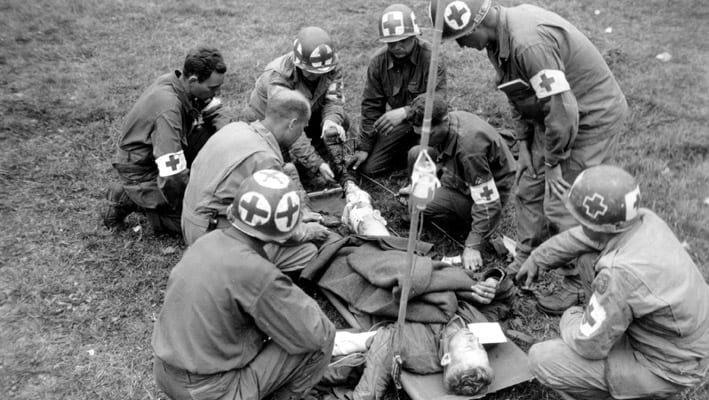Food poisoning isn’t something that should be taken lightly, as it can lead to extremely serious illnesses that can land you in hospital. We’ve all read about E Coli, salmonella and other types of food poisoning, but what causes these deadly diseases and how can we reduce the risks of consuming hazardous foods?
Storing perishable foods at the correct temperature is paramount to avoid the build-up of dangerous bacteria that lead to food poisoning. Unless food is stored in a refrigerator, the bacteria can multiply quickly. Bacteria can grow within two hours – or if the temperature is 90˚F or higher, it can form within one hour!

© metamorworks / Adobe Stock
There are many different types of bacteria and the term “food poisoning” is broad, describing any illness caused by consuming tainted food or drink. The World Health Organisation uses the term “foodborne illnesses” to describe the diseases that can enter the body in this way.
Common bacteria
The most common cause of food poisoning in the UK is campylobacter bacteria. Found in raw or undercooked meat and unpasteurised milk, and with an incubation time of between two to five days between eating the contaminated food and displaying symptoms, the illness lasts for up to a week for most people, although for those with a weakened immune system, it can be more serious.
Another common bacteria is listeria monocytogenes, found in chilled foods, including cooked meats and pâté, pre-packed sandwiches and soft cheeses, like camembert and brie. Always eat these foods by their use-by date. This bacteria is particularly dangerous for elderly people, pregnant women and anyone with a weakened immune system. It can be fatal for the elderly and cause miscarriages for pregnant women.
Salmonella
Particularly unpleasant, the symptoms of salmonella bacteria include severe diarrhoea, stomach cramp, nausea, vomiting and a high fever. It can be present in raw or undercooked meat, milk, raw eggs and other dairy products. Symptoms usually occur within 12 and 72 hours and can last for up to seven days. Salmonella can be so serious that sufferers can end up in hospital.
E Coli is also nasty bacteria, with the shiga toxin producing the strain responsible for most infections – E Coli 0157. Most cases are caused by eating undercooked beef (including burgers, mince and meatballs), or by drinking unpasteurised milk. The symptoms of diarrhoea and stomach cramps occur within three or four days. Some people can develop a more serious and potentially fatal infection, haemolytic uraemic syndrome. Children under five years are most at risk.
Less common bacteria
Shigella bacteria can develop in any food washed in contaminated water. It causes sickness and diarrhoea, which can last for up to a week. In a small number of cases, a more serious infection, bacillary dysentery, can develop.
Clostridium perfringens bacteria can be caused by undercooking food, or storing it at too high a temperature. It can cause gastroenteritis, a severe inflammation of the stomach and intestines, which causes diarrhoea and vomiting. Common sources include meat that has been prepared and kept warm for longer than two hours before being eaten and casseroles, stews and gravy that haven’t been stored properly.
Raw foods, particularly vegetables that have been in contact with soil, can be contaminated by bacillus cereus, which can cause gastroenteritis.
Norovirus
Some foods, particularly shellfish such as oysters, have a higher risk of causing norovirus, which results in sickness and diarrhoea. It can be spread from person to person, as well as through contaminated food or water. The symptoms will begin within 24 to 48 hours and will last around two days.
It is a particularly nasty virus, which has been colloquially called the “vomiting bug” because the symptoms are so unpleasant. It can be more dangerous for elderly people and young children.
Preventing food poisoning
Studies have revealed foodborne illnesses account for the sickness of one-sixth of the population every year, so they are not to be taken lightly.
European and British safety regulations govern the food production industry in the UK. The General Food Law Regulation (EC) 178/2002 sets out a framework for all food businesses. It ensures that food is transported and stored at the correct temperature to prevent the formation of bacteria.
Foods that must be stored under controlled temperatures include raw products such as meat, poultry and fish, smoked and cured fish, dairy products and uncooked or partly cooked dough and pastry – all of which are particularly susceptible to bacteria.
The meat production industry has its own stringent regulations, covering everything from animal feeds to the meat that consumers buy in their local shops. Temperature-controlled storage facilities are required, such as cold rooms, freezers and meat rail cold stores.
Food retailers
Whether it’s the supermarket, the butcher, other food retail outlets or catering businesses, when the food reaches its destination, strict storage procedures must be followed. To avoid cross-contamination, cooked and raw products are never stored together in cold storage.
Bacteria doesn’t grow at a temperature of -18°C or lower. An appliance thermometer is used to check the temperature of the cold storage facilities. If the food is stored at a higher temperature than this, it can be more susceptible to the presence of bacteria, especially over a period of time.
Penalties
Under the Food Safety Act 1990, anyone in the food manufacturing industry who breaks the law, causing an outbreak of food poisoning, faces tough penalties. The Magistrates’ Court can fine offenders up to £5,000 per offence. They can even impose a jail term of up to six months.
In very serious cases, the Crown Court can impose an unlimited fine, or send perpetrators to jail for up to two years. Indeed, this emphasises the importance of food safety regulations to prevent illnesses and possibly fatalities.
1COLD’s food safety solutions include cold stores, cold rooms and industrial chillers for the food industry. Please contact us for further information.




